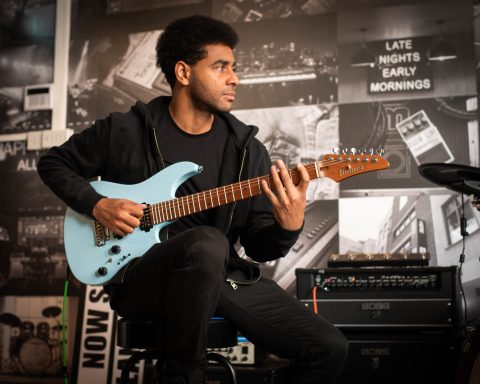Maybe you’re new to the world of overdrive and distortion pedals, or you’re simply looking to add a new flavor or texture to your tone. Either way, you can’t go wrong with one of the mainstays of the BOSS drive pedal range. But more to the point: Which one?
The DS-1 Distortion, SD-1 Super Overdrive, and BD-2 Blues Driver are some of the longest-running and most popular BOSS drives of all time. They are great places to start. Read on to find out a bit more about the differences between these three pedals. How they sound, how they’re used, and which one might work for you.
DS-1: The Original Distortion
You just can’t have a conversation about distortion pedals without starting with the DS-1, the OG BOSS distortion. To begin with, it’s the pedal with the longest production run in history. The DS-1 has remained in constant production from 1978 until today. In addition, it’s quite simply, the best-selling distortion pedal in history.
The DS-1 Distortion is not about subtlety. It’s raw, punk, rock ‘n’ roll energy distilled into a seemingly innocuous orange pedal. With its razor-sharp, hard-edged distortion sound, the DS-1 has been key to defining the sound of musical movements. These range from grunge artists like Kurt Cobain to virtuosic instrumental rocker Joe Satriani.
An important thing to know is that the DS-1 is only as good as what you’re running it into. If you pair it with a small, cheap amp, you might turn it on and find yourself wondering what all the hype is about. However, if you run it into a great-sounding amp, the DS-1’s distinctive distortion sound will seamlessly meld with your base tone. The results are chunky, edgy, and authoritative rock sounds, bursting with energy and harmonic sustain. Just ask Steve Vai.
SD-1: Asymmetric and Amp-Like
In 1977, BOSS released the OD-1 Overdrive. It made history as the very first pedal to depart from the ragged, hard-edged fuzz-style effects of the psychedelic ’60s. Instead, it utilized “asymmetric clipping” to replicate the organic tone and dynamics of an overdriven tube amp.
The SD-1 Super Overdrive debuted in 1981. It took the tube-like overdriven OD-1 sound and added the wide-ranging versatility of a Tone control. With the incorporation of this new feature, it became an instant classic.
So, what does it sound like? Well, for starters, the tone profile of an SD-1 features a mid “hump.” This means there is a midrange boost while the bass and treble get pulled back slightly. Played into a clean guitar amp, the SD-1 yields a warm, creamy, soft-clipping tone. It has a natural, amp-like compression and dynamics in the vein of classic British sounds. The SD-1 been a mainstay on the Edge’s pedalboard since its release along with the OD-2 Turbo Overdrive.

However, using an SD-1 to push the front of a crunchy Marshall amp is where many ’80s pros found their tonal nirvana. The mid-hump EQ profile and level boost work together to slam the amp into screaming high-gain overdrive. All the while, it while tightens up the overall response. This makes the SD-1 the weapon of choice for hair metal heroes like Zakk Wylde (Ozzy Osbourne), Richie Sambora (Bon Jovi), and Warren DeMartini (Ratt).
"The results are chunky, edgy, and authoritative rock sounds, bursting with energy and harmonic sustain."
BD-2: The Blue Blues Box
As the name implies, the Blues Driver is the perfect companion for emotive blues guitar. Its expressive gain structure reacts organically to every nuance, from picking attack to dynamics.
Tonally, it sits somewhere between the SD-1 and DS-1. The BD-2 has a stiffer attack than an SD-1, and a brighter, more scooped sound. Some might say it’s more transparent than the big mid-hump of the SD-1. This strident drive sound, reminiscent of classic combos, slices through mixes with ease. The BD-2 also has a surprising amount of gain on tap. From barely-there clean boost to near-fuzz territory and a whole lot in between, it’s all in there. Bring on those stinging, searing blues licks.
It’s hard to beat the heritage of the two other luminaries of the drive/distortion world. Still, since its debut in 1995, the Blues Driver has become as much of a staple as the DS-1 and SD-1. Notable users like John Mayer (during the John Mayer Trio era) and Prince turn to the BD-2. These icons use it for everything from light, touch-sensitive overdrive to cranked distortion.
"Part of the fun of drive pedals is combining or stacking favorites to create a unique drive tone."
The Stack Up
Hopefully, by now you’ve got a bit more of an idea of how these three classics stack up against each other. This brings up a final point. You don’t need to choose just one. In fact, part of the fun of drive pedals is combining or “stacking” favorites to create a unique drive tone. But that’s a whole different discussion for a different day. Regardless, crank those drives and make some noise.






